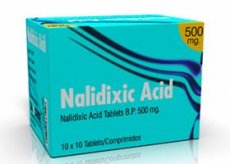Medical expert of the article
New publications
Preparations
Nalidixic acid
Last reviewed: 03.07.2025

All iLive content is medically reviewed or fact checked to ensure as much factual accuracy as possible.
We have strict sourcing guidelines and only link to reputable media sites, academic research institutions and, whenever possible, medically peer reviewed studies. Note that the numbers in parentheses ([1], [2], etc.) are clickable links to these studies.
If you feel that any of our content is inaccurate, out-of-date, or otherwise questionable, please select it and press Ctrl + Enter.

Indications Nalidixic acid
It is indicated mainly for the treatment of infectious processes (caused by bacteria sensitive to the action of drugs) in the urinary tract: pyelitis with cystitis, and also pyelonephritis. The drug demonstrates its highest efficiency in the treatment of acute forms of infections.
It is also used to prevent the development of infections following operations on the bladder and kidneys.
The product is recommended for the treatment of cholecystitis with enterocolitis, as well as inflammatory processes in the middle ear and other pathologies that are provoked by bacteria sensitive to drugs (they are resistant to other antibacterial drugs).
Pharmacodynamics
The medicine is effective in the case of infectious processes caused by gram-negative microbes, as well as dysentery, intestinal, and typhoid bacilli and Proteus (a type of microbe that, in a certain environment, can provoke infection of the stomach and small intestine), as well as Klebsiella pneumoniae (a microorganism that causes pulmonary inflammation and local suppuration processes). It has bactericidal and bacteriostatic properties (interferes with the reproduction of pathogenic microbes and destroys them). Its effectiveness is also high in relation to strains resistant to sulfonamides and antibiotics.
It has a weak effect on gram-positive cocci (pneumo-, staphylo- and strepto-), as well as pathogenic anaerobes (which can live in conditions of complete absence of oxygen and provoke human diseases).
Pharmacokinetics
The absorption of the drug is fast and almost complete (in the digestive tract). The bioavailability level is 96%. The substance requires 1-2 hours to reach peak serum levels, and 3-4 hours to achieve a similar level in urine.
The drug with its active decay product is distributed within many tissues, and most actively this occurs within the urine and kidneys. The serum levels are quite low. A small amount of the drug penetrates the placental barrier and passes into breast milk. The metabolism of the element occurs within the liver (30% of the active decay product, hydroxynalidixic acid, is also metabolized).
Excretion occurs via the kidneys: 2-3% of the substance is excreted unchanged, another 13% is excreted as an active decay product. The remaining 80% is excreted as inactive decay products. About 4% is excreted with feces.
The serum half-life (assuming normal renal function) is 1.1-2.5 hours. If there are renal dysfunctions, this figure is 21 hours.
Almost complete excretion occurs within 24 hours.
Dosing and administration
The adult dose is 0.5 g of the drug, and in case of severe infection, you need to drink 1 g four times a day. The therapeutic course lasts at least 1 week. In case of long-term treatment, you need to drink 0.5 g of the drug four times a day.
The pediatric dosage is calculated at a ratio of 60 mg/kg, and the daily dose is divided into 4 equal doses.
Use Nalidixic acid during pregnancy
It is prohibited to prescribe to pregnant women.
Contraindications
Contraindications include: suppression of respiratory processes and liver dysfunction, as well as children under 2 years of age.
It is prescribed with caution to people suffering from renal dysfunction.
The drug cannot be combined with nitrofurans, because this weakens its antibacterial properties.
 [ 29 ]
[ 29 ]
Side effects Nalidixic acid
Often there are no problems with using the drug, but sometimes side effects such as diarrhea, dizziness, vomiting, headaches, and nausea may develop.
It is also possible that allergy symptoms may appear - increased temperature, skin inflammation or dermatitis, an increase in the number of eosinophils (development of eosinophilia), and in addition, the sensitivity of the skin to sunlight may increase (development of photodermatosis).
People suffering from cerebral circulatory disorders, as well as epilepsy or Parkinsonism, may develop seizures.
It is necessary to avoid the risk of overdose in children, because it can provoke the occurrence of severe convulsions.
If the negative effects are severe, complete or temporary discontinuation of the drug is required.
Overdose
Overdose symptoms include: increased intracranial pressure, seizures, toxic psychosis, or metabolic acidosis. Overdose can also cause vomiting with nausea and lethargy.
If disorders develop, the patient must be sent to inpatient treatment, where doctors will closely monitor him. Supportive and symptomatic therapy is carried out.
Interactions with other drugs
The drug increases the effect of indirect anticoagulants, and nitrofurans can weaken its antibacterial properties.
Combination with warfarin can increase the strength of the latter's effect. Therefore, when combined, it is necessary to monitor the INR or PT indicators. In addition, it may be necessary to adjust the dosage of the anticoagulant.
Since the development of the antibacterial effect of nalidixic acid requires the proliferation of pathogenic bacterial cells, the properties of the drug may be inhibited when bacteriostatic agents (such as chloramphenicol and tetracycline) are used.
Combined use with melphalan increases the likelihood of developing gastrointestinal poisoning.
Attention!
To simplify the perception of information, this instruction for use of the drug "Nalidixic acid" translated and presented in a special form on the basis of the official instructions for medical use of the drug. Before use read the annotation that came directly to medicines.
Description provided for informational purposes and is not a guide to self-healing. The need for this drug, the purpose of the treatment regimen, methods and dose of the drug is determined solely by the attending physician. Self-medication is dangerous for your health.

